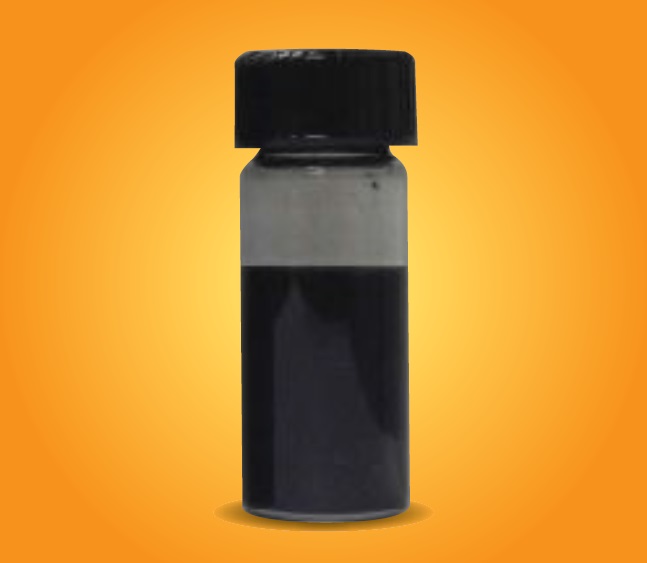Evaluation of a new lubricant additive: Crumpled graphene balls
Dr. Neil Canter, Contributing Editor | TLT Tech Beat April 2016
The wear performance of this additive at a low treat rate in PAO is superior to a commercially available 5W-30 engine oil.
KEY CONCEPTS
•
Crumpled graphene balls demonstrate greater stability in dispersions with base stocks such as PAO due to their resistance to aggregation.
•
Testing for friction and wear shows that crumpled graphene balls exhibit better performance over a longer time frame than other types of graphene dispersions.
•
Better results for friction and wear are found with a 0.1% dispersion of crumpled graphene balls in PAO compared to a commercially available 5W-30 engine oil.
GRAPHENE IS KNOWN TO EXHIBIT A HIGH DEGREE OF LUBRICITY, and the frictional properties of fluorinated graphene at the nanoscale were discussed in a previous TLT article (
1). The structure of graphene is two-dimensional sheets of carbon organized into hexagonal honeycombs.
Research has looked at developing materials that can achieve coefficient of friction values below 0.005, which is known as superlubricity (
2). A previous TLT article discussed simulations done by sliding graphene against a diamond-like-surface (DLC). Superlubricity was detected at the nanoscale for the first time when graphene particles wrapped around the DLC surface to form nanoscrolls.
The lubricity benefit of graphene has been observed in the material’s use as a solid lubricant, but most lubricant applications involve the use of a fluid. Forming stable dispersions of solid lubricants has proven to be difficult. In most cases, solid lubricants will either drop out of solution or—if evaluated at the nanoscale—aggregate into larger particles that do not impart lubricity.
Jiaxing Huang, associate professor of materials science and engineering at Northwestern University in Evanston, Ill., says, “We have recognized the limitations in dispersing various forms of graphene in liquids. One option that we are evaluating is crumpling graphene into balls.”
The process for crumpling graphene starts with the preparation of its derivative—graphene oxide that is readily dispersible in water. Huang continues, “Graphene oxide sheets are suspended in nebulized, aerosol water droplets produced by a humidifier and then squeezed in all directions through a process called capillary compression. Heat is applied during the evaporation process to reduce graphene oxide to graphene leading to the formation of crumpled graphene balls exhibiting a diameter of a few hundred nanometers.”
Crumpled graphene balls exhibit a rough surface texture with a reduced area of contact when placed on a surface. But they become strain-hardened enabling them to maintain the crumpled shape.
Huang says, “The important aspect of crumpled graphene balls is that van der Waals attraction between particles is very weak because the contact area between balls is low, even when they are compressed. In a similar manner to crumpled paper balls, graphene balls of a similar shape do not stack, and as a consequence, resist aggregation.”
Huang also points out that crumpled graphene balls contain a great deal of free volume and solvent-accessible surface area inside enabling them to readily absorb solvents such as mineral oil. He feels that upon application of stress, the crumpled graphene balls can then release the oil leading to a high degree of surface wetting.
Huang and his colleagues have now evaluated the lubricity properties of crumpled graphene balls in a lubricant base stock and compared them to a commercially available 5W-30 engine oil.
LOW TREAT RATE
Huang and his collaborators, professor Yip-Wah Chung and professor Q. Jane Wang (both STLE members), sonicated crumpled graphene balls into 4 cSt polyalphaolefin (PAO) and compared the dispersion produced to the results seen with graphite platelets, reduced graphene oxide sheets and carbon black. All of the additives are used at treat rates of 0.01% and 0.1% by weight. Once sonication is finished, all four carbon sources are completely dispersed in PAO.
But the agglomeration was detected in the graphite platelets, reduced graphene oxide sheets and carbon black after only a few hours. Huang says, “In contrast the crumpled graphene ball-based dispersion is stable and remains stable for one to two days. Even when crumpled graphene balls start to sediment over time, a uniform dispersion is re-established when the fluid is agitated.”
An image of a 0.1% dispersion of crumpled graphene balls in PAO is shown in Figure 2.
 Figure 2. Crumpled graphene balls display greater stability in dispersions with hydrocarbon base stocks (such as shown in this image of a 0.1% dispersion in PAO) that leads to superior friction and wear results. (Figure courtesy of Northwestern University.)
Figure 2. Crumpled graphene balls display greater stability in dispersions with hydrocarbon base stocks (such as shown in this image of a 0.1% dispersion in PAO) that leads to superior friction and wear results. (Figure courtesy of Northwestern University.)
Friction testing and wear reduction measurements are done using a pin-on-disk tribometer. Huang says, “We measured the coefficient of friction at the two additive treat rates over a time frame of 2,000 seconds. At higher concentrations only the crumpled graphene ball dispersions displayed a constant coefficient of friction around 0.11. The coefficient of friction results for the other three carbon sources increased at the higher concentration and the longer the experiments were run. This is an indication that the dispersions for graphite platelets, reduced graphene oxide sheets and carbon black started to fall apart due to agglomeration.”
Similar results are seen in the wear testing. All of the carbon sources besides crumpled graphene balls display significantly higher wear rates at 0.1% due to agglomeration. The researchers then evaluated the 0.1% dispersion of crumpled graphene balls versus a PAO-based, commercially available 5W-30 engine oil. In pin-on-disk testing, the crumpled graphene ball dispersion displayed better friction performance and wear test results by a margin of 15% versus the commercial engine oil.
Huang says, “We intend to evaluate the temperature dependency of the crumpled graphene ball-based fluid to determine the stability of dispersions at extreme temperatures. In general, colloidal dispersions are sensitive to temperatures.”
Additional information can be found in a recent reference (
3) or by contacting Huang at
jiaxing-huang@northwestern.edu.
REFERENCES
1.
Canter, N. (2015), “Frictional properties of fluorinated graphene at the nanoscale,” TLT,
71 (2), pp. 12-13.
2.
Canter, N. (2015), “Superlubricity: Seen at the macroscale for the first time,” TLT,
71 (10), pp. 10-11.
3.
Dou, X., Koltonow, A., He, X., Jang, H., Wang, Q., Chung, Y. and Huang, J. (2016), “Self-dispersed crumpled graphene balls in oil for friction and wear reduction,”
Proceedings of the National Academy of Sciences,
113 (6), pp. 1528-1533.
 Neil Canter heads his own consulting company, Chemical Solutions, in Willow Grove, Pa. Ideas for Tech Beat items can be sent to him at neilcanter@comcast.net
Neil Canter heads his own consulting company, Chemical Solutions, in Willow Grove, Pa. Ideas for Tech Beat items can be sent to him at neilcanter@comcast.net.